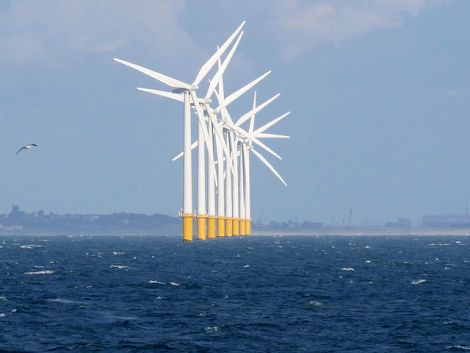Energy / ‘Fundamental right’ for community to benefit from offshore wind development
THE SHETLAND community has a “fundamental right” to benefit from offshore wind developments in the waters around the isles, according to the council’s economic development manager.
Tommy Coutts also said community benefit from offshore wind being targeted towards “larger-scale, long-term” projects – such as housing and transport connectivity – could deliver a lasting positive impact.
But, responding to a Scottish Government consultation on “net zero” energy development community benefits, Coutts said it was essential that displacement of fishing activity from development “be taken account of in developing offshore wind infrastructure, mitigated where possible, and compensated for where required”.
Meanwhile Shetland Community Benefit Fund Ltd – which was set up to receive funds from the Viking wind farm – has advocated community benefit increasing from the current principle of £5,000 per megawatt a year to in excess of £7,500 per megawatt.
Two offshore wind farms are planned to the east of Shetland – the 2.3GW Arven development and the smaller 500MW Stoura project.
They are still in the planning phase, and if they go ahead then it would only be the 2030s before they were operational.
Power would be sent to Shetland, before being exported via a second HVDC subsea that would run to mainland Scotland.
Given their generating capacity, they could in theory result in many millions of community benefit a year.
The Scottish Government recently consulted on community benefits from net zero energy developments as part of a review of good practice principles for onshore and offshore renewable energy.
Locally, SSE Renewables’ 103-turbine Viking wind farm pays out around £2.2 million a year in community benefit under the principle of £5,000 per installed megawatt per annum.
However earlier this year Shetland Islands Council approved a new set of principles around community benefit which will be used in future local negotiations with energy developers.
Become a member of Shetland News
One proposal is for five per cent of gross net revenue from future onshore wind developments to go back to the community, which would mark a considerable and more profitable shift from existing schemes.
For offshore wind there is a target of a minimum of 2.5 per cent of gross project revenues, with a minimum of £5,000 per installed megawatt.
Responding to the consultation on behalf of the SIC, Coutts said local residents and businesses have long been active across the waters within the area of sea where Shetland is the nearest landfall.
“In addition, Shetland fishermen operate in all these waters and historically used to sail and row across all parts of them to seek a livelihood. Shetland has historically depended on our surrounding waters for economic, social and cultural activity and has a long track record of interest, activity and dependence on the seas around the islands,” he said.
“Offshore renewables is another chapter in the productive history of those seas and one which the Shetland community has a fundamental right to share in.”
Coutts said the SIC does not believe that visibility of turbines is a material component in defending a host community, but that geography and location is.
He also said it is imperative that the local authority be considered the “key strategic player and decision-maker in delivering community benefits from energy projects”.
Meanwhile Coutts said community interests would be protected through legislation on community benefit agreements, rather than being voluntary as they are now.
He said the SIC “remains concerned that the continuing voluntary status of community benefit agreements mean that there is no real enforcement mechanism and thus little or no effective action to address non-compliance”.
He also advocated offshore wind community benefit going towards large-scale projects that could create “lasting infrastructure and economic resilience”.
This could include investment in affordable and sustained housing, and funding for maritime infrastructure, energy hubs and green STEM skills.
He also said funds could be used to support development in transport connectivity, “particularly high cost improvements to inter-island transport infrastructure”.
Coutts also said that addressing the high cost of local energy could reduce bills for every Shetland household.
“Such projects could strengthen Shetland’s economy in the long term, while supporting local supply chains and workforce development,” he wrote.
“These would also ensure that funding is invested in a way that delivers long term positive change to areas of island life where significant capital investments and complex long-term planning are required.
“A balanced approach to distribution of funds, incorporating a number of different funding routes, could ensure that a portion of funds go to major, long-term projects (housing, infrastructure), while a portion is retained to support smaller, flexible community grants for grassroots initiatives.”
A key concern around offshore wind development is the impact on the fishing industry, particularly in traditional grounds to the east of Shetland.
Coutts said it is clear that “potentially significant displacement or disturbance” of fish catching activity off of Shetland would take place as a result of offshore wind development”.
“It is essential that any such displacement be taken account of in developing offshore wind infrastructure, mitigated where possible, and compensated for where required,” he wrote.
“Such compensation measures should be considered wholly separate to community benefit mechanisms.”
Coutts also commented that shared ownership of offshore wind developments could offer Shetland a “transformative economic opportunity”.
He said this could enable local communities to “secure long-term wealth, decision-making power, and economic security, and leverage the local experiences in dealing with the oil and gas sector”.
Meanwhile Shetland Community Benefit Fund Ltd, the organisation which receives money from SSE from the Viking wind farm before distributing it to projects, said in response to the organisation that local authorities should not deliver community benefit funding.
“There is a great concern that community benefit funds will be used by statutory authorities to fund statutory responsibilities leaving little or no funding available for community focused projects,” it said.
“There is already evidence of ‘wealth funds’ being used to off-set shortfalls in local authority budgets.
“This demonstrates an inability by local authorities to be sustainable with the funding they already have. Community benefit should not be seen by national, regional or local authorities as a means to replace statutory responsibilities.”
The organisation said decision makers should be a local community benefit fund management group, made up of members of the local community.
It also advocated a large-scale community consultation, like it carried out regarding the Viking funds.
Responding to a question about what could be done to increase the impact of community benefits, the organisation said increasing the funding from developers beyond £7,500 per MWh – paired with a public consultation – would maximise benefits.
It also advocated keeping funds at a local level.
“There is great risk in nationalising funds in that they won’t meet the needs of affected communities,” Shetland Community Benefit Fund Ltd said.
“For example, improving national infrastructure is not going to bring significant lasting changes to the rural communities hosting renewable energy developments.
“National projects (i.e. Edinburgh trams, CalMac Ferries, roads/schools etc) are unlikely to meet the day-to-day issues encountered by remote and rural communities hosting renewable energy developments, e.g. affordable housing, improved broadband/IT and retaining young people.
“Community benefits should not be a substitute for shortcomings from local and national government and should not be used to fund projects which are a statutory responsibility.”
Meanwhile the Scottish Fishermen’s Federation said it was “extremely disappointing and indeed disrespectful” that the consultation did not reference the “negative socio-economic impacts that offshore wind developments will have on Scotland’s fishing industry”.
It added: “The fishing industry faces significant long-term negative impacts from offshore wind developments, including displacement from traditional fishing grounds, disruption to marine ecosystems, and potential loss of livelihoods.
“These impacts are not adequately addressed by short-term disruption payments.”
The federation said without a robust compensation framework, the fishing industry will “bear the brunt of the negative consequences of offshore wind developments, undermining the viability of our sector”.
“It is imperative that the Scottish Government ensures that developers are held accountable for the long-term impacts of their projects and that appropriate compensation mechanisms are put in place to protect the livelihoods of those in the fishing industry.”
The Scottish Government said the consultation was part of a review of the Good Practice Principles for onshore and offshore renewable energy, which “seeks to ensure that our guidance helps communities and developers get the best from community benefits”.
It added: “We recognise that renewable technologies are at different stages of maturity, existing in distinct physical, operational, and commercial environments.
“There is a need to support the growth of industry and ensure the substantial supply chain and workforce benefits are captured here in Scotland, whilst recognising the role that coastal, fishing, island, rural, and in some cases urban communities play in hosting projects, and the electricity network infrastructure required to connect them.
“There is an opportunity to ensure renewables play a role in securing a just transition to net zero.”
Become a member of Shetland News
Shetland News is asking its readers to consider paying for membership to get additional perks:
- Removal of third-party ads;
- Bookmark posts to read later;
- Exclusive curated weekly newsletter;
- Hide membership messages;
- Comments open for discussion.
If you appreciate what we do and feel strongly about impartial local journalism, then please become a member of Shetland News by either making a single payment, or setting up a monthly, quarterly or yearly subscription.


















































































